There has been a lot of talk in recent years about “cultural appropriation.” The point tends to be that it is appropriate for some people to wear certain costumes or perform certain kinds of music because that is part of their culture, but it is appropriation for other people to wear those costumes or perform that music, because it is not part of their culture.
Having spent much of my life as a white guy playing and writing about blues, this conversation is very familiar to me, and I recently have been thinking, reading, and talking with people about it more than ever. So I was interested when a news story broke about Justin Trudeau, Canada’s Prime Minister, darkening his skin and donning a robe and turban to go to a costume party as Aladdin, and that sparked the following meditation.
A lot of people have referred to Trudeau’s makeup as blackface, and my first reaction was to say, “No, it’s not.” Because blackface is not just white people darkening their skin; it is a quite specific kind of makeup.
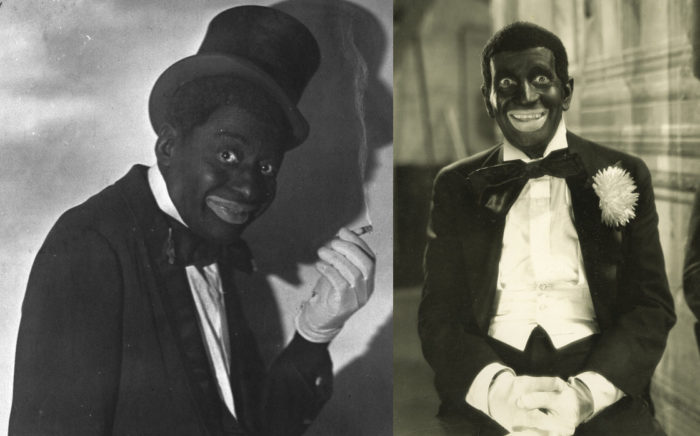
Both of these performers are in blackface. On the left is Bert Williams, an African American singer and comedian born in the Bahamas and raised in California, who was one of the most brilliant and influential Black performers of the early twentieth century. On the right is Al Jolson, a Jewish singer born in Lithuania and raised in New York.
In modern US racial terms Williams was Black and Jolson was white, but it would be ridiculous to argue that the make-up was not racist when Williams wore it. The tradition of blackface makeup is racist, whatever the ancestry of the person wearing it, and the fact that for many decades Black comedians had to use that make-up to have successful careers is at least as ugly as the fact that white comedians used it. Indeed, most Black comedians stopped wearing it by the 1940s — when many white comedians were still wearing it — because they were particularly aware of what it represented.
But this stuff can get complicated…
Sammy Davis Jr. recalled in his autobiography that when he was three years old and started working in vaudeville with his father and uncle, his uncle helped him put on blackface makeup, then told him: “Now you look like Al Jolson.”
Jolson had just hit internationally in The Jazz Singer, the first successful movie with sound, and for a while he was the most popular stage performer in the United States. So in that context you could say Davis wasn’t made up to look like a Black person, or even as the racist stereotype of a Black person — you could say he was made up to look like a Jewish movie star. As he tells the story, he seems to have thought it was fun to look like a Jewish movie star, and throughout his later career he continued to feature impressions of white singers and movie stars in his act.
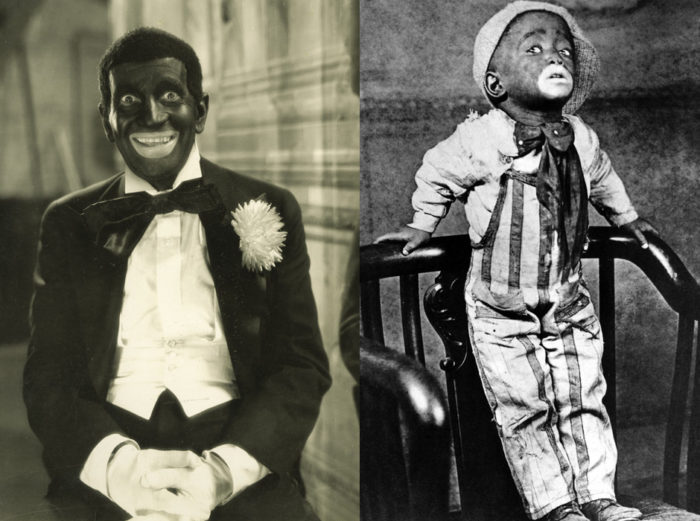
This is the only picture I’ve found of Davis in that makeup, and I’m not even sure he’s wearing black make-up — he describes his uncle applying burnt cork to his face, but in this photo the most obvious makeup is the white greasepaint around his mouth. So, in a weird way, you could argue he’s actually wearing whiteface…
…though, obviously, in a larger sense it’s still blackface.
My point is not that a Black kid wearing white makeup to look like a white performer in blackface makes the makeup less racist or offensive. My point is is that a Black kid performing in that makeup, in that context, was unquestionably racist, and also weird and complicated.
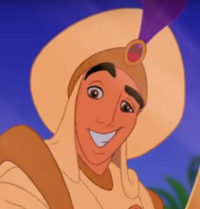
Getting back to the Trudeau/ Aladdin story: when I read what everyone had written about it I found that most writers do not describe his make-up as blackface—
They describe it as brownface, a recent term for white actors making themselves up as Arabs, Latinos, and other people whose ancestry is neither African nor European.
For example, there were protests against the new live-action Disney production of Aladdin for using brownface, because some of the actors and extras are Europeans made up to look like Arabs.
An odd twist to those protests is that a lot of people argued that the production should have hired Pakistani, Indian, or Bangladeshi actors — which is odd because the original Aladdin character was from somewhere in the region of present-day Iraq or Syria. The historical source of his story seems to have been a Syrian Maronite Christian and, in terms of ancestry and phenotype, Syrians and Iraqis are closer to Greeks or southern Italians than they are to Indians or Pakistanis.
That does not necessarily mean the protesters were wrong, because whatever we are talking about when we discuss race, it is not simply a matter of ancestry or phenotype.
I recently heard Imani Perry give a talk at the Philadelphia library, and she made the point that whiteness in the sense we use that term in the United States or Europe is not a color: it is the absence of color. It is not a particular ethnicity: it is the absence of ethnicity.*
If that is what we mean by “white” — that it is what people in Europe and the United States call those of us who are not marked as “ethnic” — by this Eurocentric standard it makes perfect sense to argue that Iraqis, Syrians, Indians, and Pakistanis are in a single category, all regarded as brown ethnics, while Greeks and Italians are white.
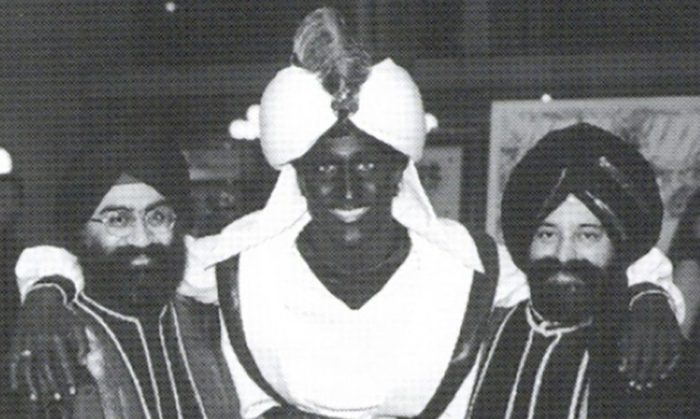
There is no better way to illustrate that point than by showing a picture of Trudeau at the notorious costume party:
Because the two men with him look like they could well be Syrian or Iraqi, and whatever the point of his make-up, it clearly does not make him look like them.
This raises an obvious question: of course it was bizarrely racialist for Trudeau to wear dark brown make-up to look like a character who, in real life, probably had roughly the same skin color as Trudeau. It is a weirdly extreme way of exaggerating and marking the character as non-white…
…but would it have been ok for Trudeau to go to a party in that robe and turban if he had not worn any make-up?
Or would it have been like Katy Perry’s geisha costume?
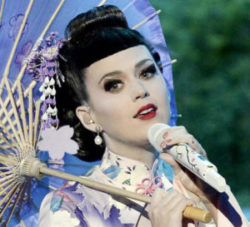
Perry was widely criticized for performing in this costume, and many people described it as yellowface, another recent coinage applied to white performers who masquerade as Asian.
The logic of this criticism is obvious, but the odd thing in this instance is that, in terms of its actual color, Perry’s make-up made her skin whiter than normal, because 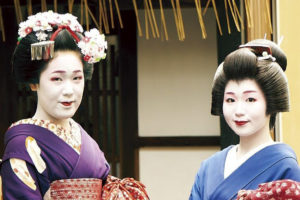 Japanese geishas traditionally whiten their faces with rice powder. If we agree that Perry is white, in color-swatch terms it would seem ridiculous to protest against her wearing white make-up…
Japanese geishas traditionally whiten their faces with rice powder. If we agree that Perry is white, in color-swatch terms it would seem ridiculous to protest against her wearing white make-up…
…but, as we all know, this is not about color in the color-swatch sense.
Which said, the subject of white make-up takes me down another odd historical rabbit hole:
Many of you will recognize this singer from the movie Casablanca…
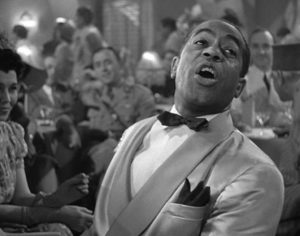
His given name was Arthur Wilson, but he was known as Dooley Wilson. He got that nickname when he was working in African American vaudeville as an Irish imitator, featuring a popular Irish dialect song, “Mr. Dooley.” For that act he wore what some modern writers call “whiteface” makeup, which makes sense because it made him look like an ethnic European…
…but scholars of ethnic vaudeville often refer to the comic Irish acts of this period as greenface, because those performers weren’t imitating ordinary white people — they were specifically imitating Irish immigrants, who were racially defined and comically stereotyped ethnics. In fact, a lot of blackface minstrel comedy was adopted from “Paddy” acts, which remained popular in Britain and the United States through the nineteenth and early twentieth centuries.
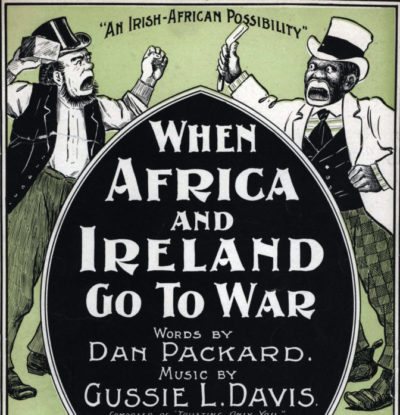
The two stereotypes occasionally overlapped, as in this comic song from 1898:
Gussie Davis, who composed the melody, was a well-known African American songwriter, and I have no information about Dan Packard’s ethnicity, but he wrote several popular “coon songs,” as blackface songs were labeled in the ragtime era.
A lot has been written about the racism of the blackface tradition, but virtually nothing about African American entertainers who performed other ethnicities. That is an omission worth correcting, since although Wilson’s choice to perform his Irish character in white make-up seems to have been relatively rare, “ethnic delineators” were almost as popular in Black vaudeville as in white vaudeville.
An ad from 1900 in the Indianapolis Freeman — one of the main African American newspapers — touted Louis Vasnier, a singing and dialect comedian who presented “Natural face expressions in five different dialects, no make up – Negro, Dutch, Dago, Irish and French.” It described him as “the only colored comedian who can do this,” but he soon had plenty of competitors. John Moore, for example, whose range included “Italian, Hebrew, Indian, Chink, Turk, villain (high and low class), straight man and blackface.”
There are very few surviving images of these artists, but here is a photo of the popular duo of Fiddler and Shelton, who were popular for what we would now call a yellowface act, and a cartoon with a portion of their routine:
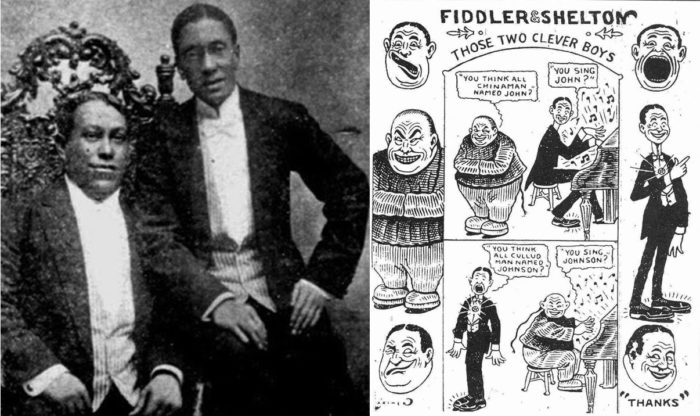
As with Vasnier, they were by no means unique. A review of Pinkey & Walker said: “As delineators of oriental characters they go to the head of the class. ‘Chinee’ Walker has already won his laurels as a ‘chink’ impersonator… His ‘Dago’ is equally as strong.” Chinese acts seem to have been particularly popular in Black vaudeville: I’ve found mentions of ten men who did them, including the jazz clarinet virtuoso Sidney Bechet, as well as couple of women.
Most comedians in Black vaudeville were men, and relatively few women seem to have specialized in ethnic material, but Lena Henderson was commended for her “splendid interpretation of Irish character singing,” the reviewer noting she “looks Irish all right, and dressed in green,” and Margie Crosby performed songs in Yiddish and was billed as “the girl with the Jewish face.”
H. Qualli Clark, an associate of W.C. Handy who composed the jazz standard “Shake it and Break It,” was likewise known for “Hebrew” imitations, one reviewer writing: “At times it was hard to believe he was a colored man, so perfect was his accent and so realistically faithful were his portrayals of a real Jew.” Among his competitors, Leroy Gresham was so successful that he was known for the rest of his career as “Kike” Gresham, though he also did blackface, Italian, and female impersonations.
A lot has been written about Irish and Jewish performers who worked in blackface, and a fair amount about those who did Irish or Hebrew acts, but I’ve never seen even a substantial paragraph about Black ethnic imitators. One reason is that there has been relatively little research on African American vaudeville in general, and another is that the study of Black performers has tended to ignore or gloss over people whose work does not fit 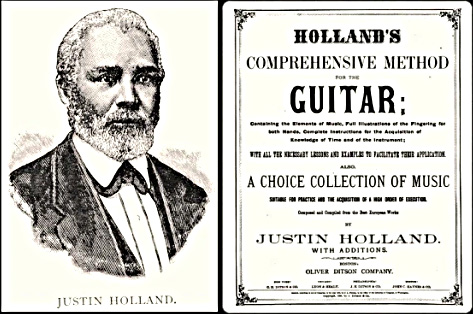 within categories marked as Black culture. There is a great deal of writing on Black artists who performed ragtime, blues, and jazz, but the deep history of African American classical music has had far less study, and likewise the many Black singers and musicians who performed in other styles that were not marked as Black, such as mainstream pop, hillbilly, Hawaiian, Italian, and so forth.
within categories marked as Black culture. There is a great deal of writing on Black artists who performed ragtime, blues, and jazz, but the deep history of African American classical music has had far less study, and likewise the many Black singers and musicians who performed in other styles that were not marked as Black, such as mainstream pop, hillbilly, Hawaiian, Italian, and so forth.
Another reason is the extent to which blackface minstrel shows have overshadowed all the other kinds of ethnic comedy. Along with professional minstrel troupes and solo stars like Al Jolson and Eddie Cantor, thousands of amateurs blacked up with burnt cork and did songs and comedy in exaggerated “darky” dialect. In comparison, the number of artists who explicitly imitated other ethnic groups was smaller, and the number of African American artists who did that was smaller still — besides which many (perhaps most) of them seem to have worked in blackface even when they were playing Europeans. Dooley Wilson was not the only one to use white make-up — a review of a Chinese impersonator named George Catlin actually criticized him for making up “too white” — but early mention of Qualli Clark’s act refers to his “blackface Jewish and Italian dialect character singing,” and Hen Wise was likewise noted for his appearance as a “blackface Hebrew…”
…which makes exactly as much sense as Justin Trudeau appearing as a blackface Syrian or Iraqi.
The fact that so many Black performers did ethnic acts does not make those acts less offensive. The portrayals of Irish, Jews, Chinese, and Italians as comical foreigners went along with discrimination in housing and employment, and by the 1920s ethnic stereotyping led to tight quotas on immigration from eastern and southern Europe, while by the 1880s Asians had been excluded both from entry and US citizenship.
It is common for people who have few victories to savor those few, and for people with little power to exercise that power on those with still less. In the battle to be recognized as full citizens, it was natural for African Americans to join in mocking immigrant outsiders, just as it was natural to join with immigrants when their interests intersected. By the same token, it was natural for immigrants striving to become fully American to assimilate American racial prejudices.
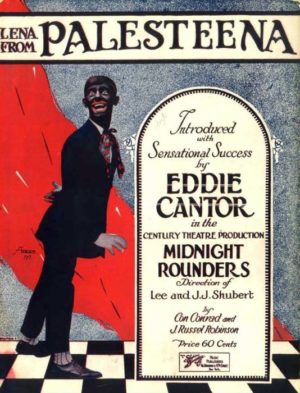 Periods of high immigration and intense anti-immigrant agitation come and go, but the bedrock of anti-Black racism remains. The Black ethnic delineators are an interesting byway of US culture, but their history does not in any way mitigate the enduring racism of blackface minstrelsy. On the contrary, the fact that you could perform pretty much any kind of ethnic caricature in blackface underlines the extent to which racism directed at African Americans has served as a more general paradigm.
Periods of high immigration and intense anti-immigrant agitation come and go, but the bedrock of anti-Black racism remains. The Black ethnic delineators are an interesting byway of US culture, but their history does not in any way mitigate the enduring racism of blackface minstrelsy. On the contrary, the fact that you could perform pretty much any kind of ethnic caricature in blackface underlines the extent to which racism directed at African Americans has served as a more general paradigm.
That is what it means when recent historians describe Irish, Italians, or Jews as “becoming white” — not that they came to be considered Anglo-Saxon, but that they ceased to be racialized the way African Americans are racialized. Native Americans were the defining “other” of the colonial period, but for the last two centuries the opposite of white in the United States has been Black, and other ethnicities have been able to blend into an American norm because Black Americans remained outside — as Toni Morrison reframed the melting pot metaphor, other people could melt because “[Black people] were the pot.”
That is one of the tricky things about the current term “people of color.” It implies a unifying category that includes everyone not marked as “white,” but to be “colored” in the United States has traditionally meant to be Black, and blackness continues to play a unique role in the American imaginary. That is in part because African Americans have such a deep history of oppression, discrimination, and stereotyping in the United States, but also because they have played such a central role in shaping American culture.
As a historian of popular music, I’m intensely aware of the way other groups have become “American” by emulating Black culture — “becoming white” by first becoming somewhat black. The original blackface minstrel stars were often Irish immigrants or their offspring; the early “white” jazz musicians who came north from New Orleans were mostly Italians, as were the “white” urban rock ‘n’ rollers. 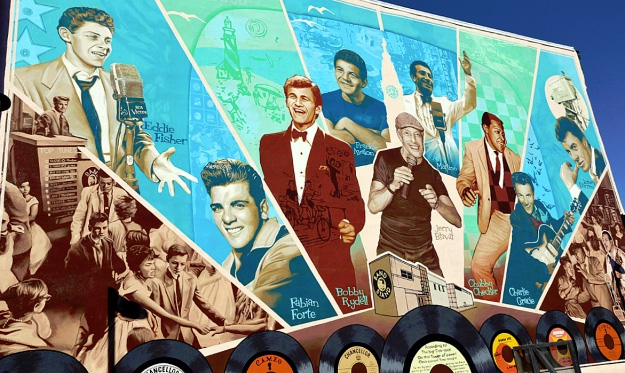 I live up the street from a mural of South Philadelphia singers of the 1950s, and aside from the Jewish Eddie Fisher and the Black Chubby Checker, all the others are Italian (though many changed their names to play down their ethnicity, Bobby Ridarelli becoming Bobby Rydell, Jimmy Ercolani becoming Jimmy Darren).
I live up the street from a mural of South Philadelphia singers of the 1950s, and aside from the Jewish Eddie Fisher and the Black Chubby Checker, all the others are Italian (though many changed their names to play down their ethnicity, Bobby Ridarelli becoming Bobby Rydell, Jimmy Ercolani becoming Jimmy Darren).
Some people argue that those young Irish, Jewish, and Italian artists were expressing their love of Black culture, not appropriating it — and taken one by one, as individuals, that makes sense. But they weren’t taken one by one: in both the jazz age and the golden age of rock ‘n’ roll, the American mainstream consistently welcomed them into venues and played their recordings in situations where Black artists were not heard — and that contrast with Black artists cemented their status as members of the white mainstream.
There is obviously far, far more to be said about all of this, but for now I’ll leave it there. I am trying to complicate some familiar discussions, but inevitably have simplified others, and will go on to explore all of this in more depth. For the moment, these are a few unfamiliar facts and passing thoughts. For the future, I look forward to many more conversations.
[Thanks to Lynn Abbott for introducing me to the subject of ethnic delineators in African American vaudeville.]
*I took notes during Imani Perry’s talk, so am reasonably sure she said this, but I recently checked with her and she says it doesn’t sound familiar. If I reworked or misunderstood her ideas, I nonetheless got this impression from hearing her, and since I find the formulation useful I’m crediting her, with this caveat.

I wonder if you’ve spoken with Rhiannon Giddens.
Only briefly, and I doubt she even remembers it. She is one of the most visible of many artists thinking about these histories and traditions, and I would love to have a chance to talk with her at greater length.